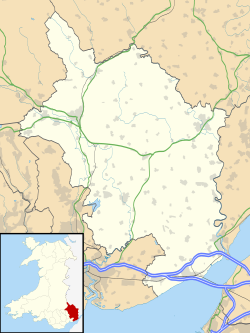| St Michael and All Angels, Llanvihangel-Ystern-Llewern | |
|---|---|
| Church of St Michael and All Angels | |
 "a fine wagon roof and unusual timber-framed belfry" | |
| 51°49′17″N2°49′27″W / 51.8213°N 2.8243°W | |
| Location | Llanvihangel-Ystern-Llewern, Monmouthshire |
| Country | Wales |
| Denomination | Church in Wales |
| History | |
| Status | parish church |
| Founded | C15th century |
| Architecture | |
| Functional status | Active |
| Heritage designation | Grade II* |
| Designated | 19 November 1953 |
| Architectural type | Church |
| Administration | |
| Diocese | Monmouth |
| Archdeaconry | Monmouth |
| Deanery | Monmouth |
| Parish | Llanfihangel-ystern-Llewern |
| Clergy | |
| Vicar | The Reverend G J R Williams |
The Church of St Michael and All Angels, Llanvihangel-Ystern-Llewern, Monmouthshire, Wales, is a parish church with its origins in the 15th century. Renovations took place in the 19th century under the direction of Thomas Henry Wyatt. It is a Grade II* listed building and an active parish church.
